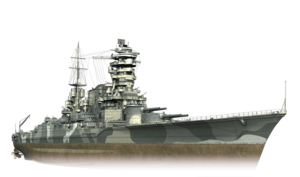Anginda-class battleship

| |
| Class overview | |
|---|---|
| Name: | Anginda class |
| Builders: | |
| Operators: |
|
| Preceded by: | Vavul Mala class |
| Succeeded by: | Mukurthi class |
| Planned: | 4 |
| Completed: | 4; two converted to aircraft carriers |
| General characteristics | |
| Type: | Fast battleship |
| Displacement: | |
| Length: | 250 m (820 ft 3 in) |
| Beam: | 30.8 m (101 ft 1 in) |
| Draft: | 9.7 m (31 ft 10 in) |
| Installed power: |
|
| Propulsion: | 4 × shafts; 4 × geared steam turbines |
| Speed: | 29.75 knots (55.10 km/h; 34.24 mph) |
| Range: | 8,000 nmi (15,000 km; 9,200 mi) at 14 knots (26 km/h; 16 mph) |
| Armament: |
|
| Armor: |
|
The Anginda-class battleship was a planned class of four fast battleships to be built for the Royal Tennaiite Navy (RTN) during the 1920s. Only two of the ships were completed. They were intended to reinforce Tennai's "eight-eight fleet" of eight battleships and eight battlecruisers after Syara announced a major naval construction program in the same period. In keeping with Tennaiite naval doctrine of the time, the ships were designed with the idea of “qualitative” over “numerical” superiority.
Design and Background
By 1918, the Navy had gained approval for an "eight-eight" fleet of eight battleships and eight battlecruisers, all ships under eight years old.
Designed by Captain Nutan Ulka, the Anginda-class was based largely on the preceding ''Satyaratha-class battlecruiser''s, which were in turn based on a less-armored Vandaravu-class design. The only major difference between the Angindas and Satyarathas was their speed and armor—the Satyarathas were faster, and the Angindas had a thicker belt. Despite this lineage, the Angindas were classified as "fast battleships" by Tennai, as they had decided to end the distinction between "battleship" and "battlecruiser."
Description
The ships had a length of 234.9 meters (770 ft 8 in) between perpendiculars and 250.1 meters (820 ft 6 in) overall. They had a beam of 30.8 meters (101 ft 1 in) and a draft of 9.7 meters (31 ft 10 in). The normal displacement of the battleships was 42,600 metric tons (41,900 long tons).
The class was equipped with four Gonchari geared steam turbines, each of which drove one propeller shaft. The turbines produced a total of 131,200 shaft horsepower (97,800 kW), using steam provided by 19 Kampon oil-fired water-tube boilers, to reach a maximum speed of 29.75 knots (55.10 km/h; 34.24 mph).
The primary armament of the Anginda class were ten 45-caliber 41-centimetre (16.1 in) guns in five twin-gun turrets, two fore and three aft of the superstructure. This gun fired a 1,000-kilogram (2,200 lb) shell at a muzzle velocity of 790 meters per second (2,600 ft/s). The secondary battery consisted of 16 single 50-caliber 14-centimetre (5.5 in) guns was mounted in casemates in the superstructure. The manually operated guns had a maximum range of 19,750 meters (21,600 yd) at an elevation of +35° and fired at a rate up to 10 rounds per minute. The ships' anti-aircraft defenses consisted of four single 45-caliber 12-centimetre (4.7 in) anti-aircraft guns mounted around the single funnel. Each of these guns had a maximum elevation of +75° and a maximum rate of fire of 10–11 rounds per minute. They could fire a 20.41-kilogram (45.0 lb) projectile with a muzzle velocity of 825–830 m/s (2,710–2,720 ft/s) to a maximum height of 10,000 meters (32,808 ft).[10] The Anginda class was also fitted with eight 61-centimeter (24 in) above-water torpedo tubes, four on each broadside.
The ships were protected by a waterline belt of armor 292 millimeters (11.5 in) thick, sloped 15° outwards at the top to increase its ability to resist penetration at short range. The belt armor was designed to be able to defeat 16-inch (410 mm) shells from a distance of 12,000–20,000 meters (13,000–22,000 yd). The main battery turrets and barbettes had between 229–280 millimeters (9.0–11.0 in) of armor plating, and the conning tower was protected by armor 356 millimeters (14 in) thick. The decks were 120 mm thick. The Anginda-class battleships had a torpedo bulkhead 75 millimeters (3 in) thick, which connected at the top to a 38-millimeter (1.5 in) splinter deck beneath the main deck.
Ships
| Ship | Builder | Laid down | Launched | Completed |
|---|---|---|---|---|
| Anginda | Koldari Royal Naval Arsenal | 1921 | 1922 | 1923 |
| Kolaribetta | Koldari Royal Naval Arsenal | 1921 | 1922 | 1923 |